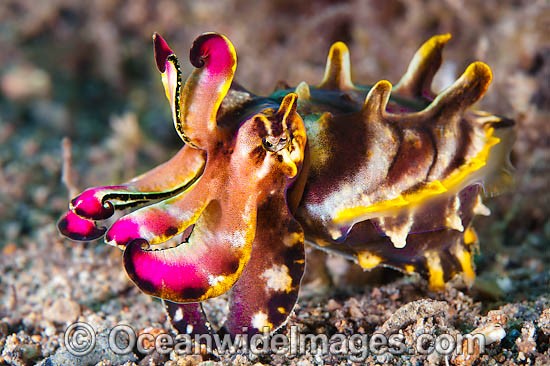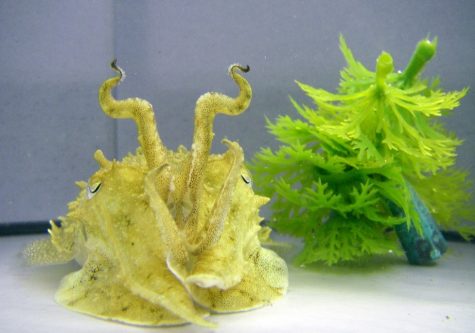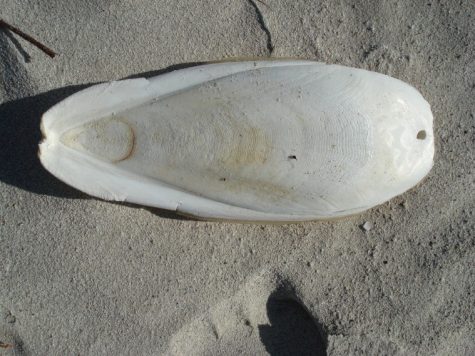Animal of the Week: The Flamboyant Cuttlefish

December 13, 2017
By Sam Schwartz ’18, Sports Editor
The “Animal of the Week” shows the amazing biodiversity of nature. These animals won’t be your typical wild Zebras, Sharks, and Bears-but some of the most endangered and magnificent and peculiar animals on the planet.
The Flamboyant Cuttlefish is a member of the Cuttlefish family, Sepiidae, which is a part of the larger phylum of Cephalopoda. Cuttlefish’s closest living relatives are Squid and Octopi, but it’s oldest living relative is the Nautilus which is still around and has evolved little in over 500 million years, long past the first dinosaurs began roaming the earth (but that animal is for another week). Cuttlefish are found in all of the major oceans (excluding the Artic), but the Flamboyant Cuttlefish, in particular, only inhabits the Indian and Pacific Oceans. For the most part, smaller species of Cuttlefish, such as the Flamboyant which maxes out at 8cm in length, are benthopelagic (live mostly near the sea floor), living closely nearby or on coral reefs. Larger species such as the Giant Cuttlefish, which reaches lengths of 1 meter, are  more pelagic (swim in the water column) due to their sheer size and lower number of predators.
more pelagic (swim in the water column) due to their sheer size and lower number of predators.
Flamboyant Cuttlefish are active during the day and usually prey on small crustaceans and fish, by using two long feeding tentacles located in between the eight tentacles. They are lighting fast and unfathomably long. Each of the tentacles consists of two long sticky pads, which once latched on to prey, are nearly impossible to shake off in time.
If the Cuttlefish is attacked, it can quickly change colors like its Octopi cousins, and even ink to scare away predators. But the Flamboyant Cuttlefish gets its name from its tentacles, which are often bright pink. In the wild, brightly colored animals are often poisonous, so scientists believed the Flamboyant Cuttlefish were mimic this tactic to avoid predation. Recently, Scientists have discovered that Flamboyant Cuttlefish actually are poisonous, which makes it the first and only cuttlefish to have that trait, and only one of three species (Blue Ringed Octopus and Mimic Octopus) in the Cephalopod family to be poisonous. The Poison is actually stored in the Cuttlefish’s muscles and has almost no common substances to other poisons.
But don’t be fooled by the Cuttlefish’s bright colors as they are still masters of disguise. Like Octopi, Cuttlefish can quickly change color and texture, helping them seamlessly blend into their environments. They achieve this with chromatophores, specially developed pigment cells located under the skin. “By controlling the size of the cells, they can vary their color and even create changing patterns. Chromatophores are connected to the nervous system, and their size is determined by muscular contractions,” explained Ellen J. Prager, the Assistant Dean at the University of Miami Rosensteil School of Marine and Atmospheric Science, in a Scientific American article. Along with using there chromatophores, Cuttlefish use there eight tentacles to mimic the appearance of animals and plants such as the Cuttlefish mimicking a fake plant pictured. Amazingly, chromatophores have independently evolved in both the  Cephalopoda family and the Chamaeleonidae family (Chameleons).
Cephalopoda family and the Chamaeleonidae family (Chameleons).
Cuttlefish move by pulsating their lateral fins that surround their body. This allows them to eerily hover above the sea floor. For longer distances, however, Cuttlefish rely on jet propulsion, using a siphon located just below the mouth. They float because of their Cuttlebone, which gives them their name. The Cuttlebone is surrounded in a gaseous membrane, which when filled allows the cuttlefish to move upward in the water column. But the Flamboyant Cuttlefish is so small because of their minute size (3 inches) that the air that fills the membrane is not enough to lift the Cuttlefish. So Flamboyant Cuttlefish, like a flightless bird, stick to the sea floor and actually seem to walk along it. Once a Cuttlefish dies (there life span is 1-2 years), all that is left is the beak, like octopi, but also its cuttlebone Once a Cuttlefish dies (there life span is 1-2 years), all that is left is the beak, like octopi, but also its cuttlebone.
As I haven’t been able to find a GIF of a Cuttlefish pulsating, here is a link to my Instagram where I got to see a Flamboyant Cuttlefish in person at the Mote Aquarium in Sarasota, Florida. Also, I highly recommend looking up a Cuttlefish feeding as the speed and ferocity of the Cuttlefish will surely catch you off guard.
https://www.instagram.com/p/imCSqQBzrE/?taken-by=180schwartz


